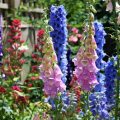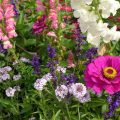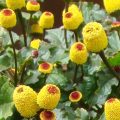Hibiscus sabdariffa is the most widely used edible hibiscus flower, and this post will provide an overview of everything you need to know about this wonderfully versatile and useful cranberry hibiscus plant.
Page Contents
Hibiscus Sabdariffa: The Most Widely Used Edible Hibiscus Flower
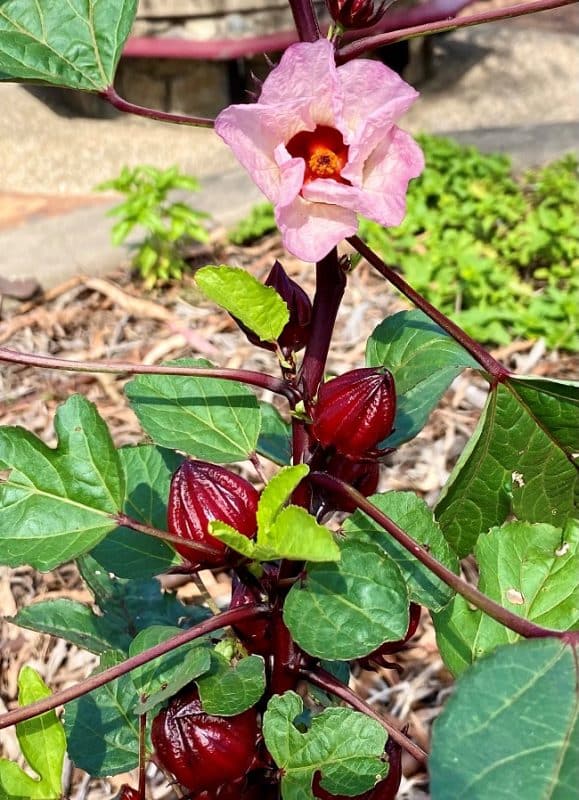
Hibiscus Sabdariffa is part of the large Hibiscus family and is the most widely used of the Hibiscus genus. Other names that it is known by are Roselle, or Rosella (in Australia), Red Sorrel, Cranberry Hibiscus, and Florida Cranberry.
It is an annual shrub with wonderful red stalks and deeply lobed leaves. It can grow to a couple of metres high and become quite bushy. Originally from Central and West Africa, the Hibiscus Sabdariffa is now grown extensively in tropical regions such as the East Coast of Malaysia, south of China, and India.
Like the rest of the hibiscus family, Hibiscus sabdariffa is entirely edible. But it is mostly known for its deep red fruit (calyxes) that are used to make jellies, jams, and beverages. Its flavor is like cranberries, with a tart yet fruity taste and slightly astringent.
The edible hibiscus flowers are not as showy as some of the more well-known hibiscus varieties and are pale yellow or pinkish white in color. They are funnel shaped with a deep crimson centre and bloom in late summer to autumn as the days get shorter.
This edible hibiscus flower is very short-lived and only last for a day before it withers and falls off, exposing the tight bud-like calyxes that protect the seeds. The fleshy fruit (which is the flower calyx) will deepen in colour as it ripens and can be harvested and used in several ways.
An interesting fact about the edible hibiscus calyx is that it contains anthocyanin pigments which are responsible for the brilliant red color that is extracted when cooked and used extensively for food coloring.
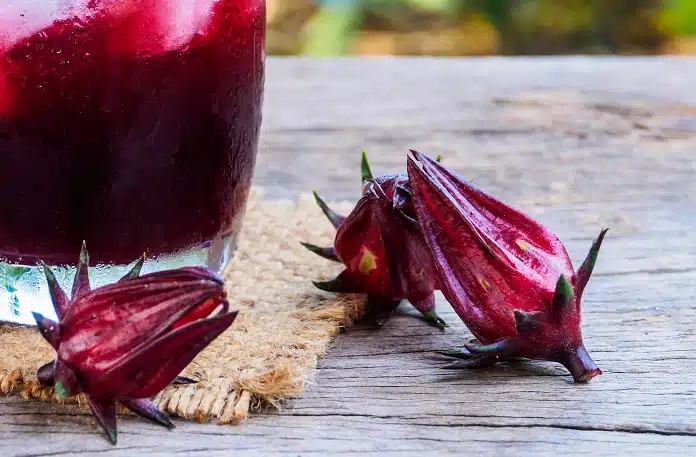
Can All Hibiscus Flowers Be Eaten?
Yes, all hibiscus flowers are edible, but the Hibiscus sabdariffa is particularly important for its calyx, which has high nutritional and medicinal properties.
The calyx is the key ingredient that is used to make Hibiscus tea. This is a brew that can be taken hot or cold and is high in nutritional value, particularly in Vitamin C, Magnesium and Calcium.
This same brew is often used as a base for cold refreshing drinks and Hibiscus cocktails.
Which Parts of the Hibiscus Sabdariffa are Edible?
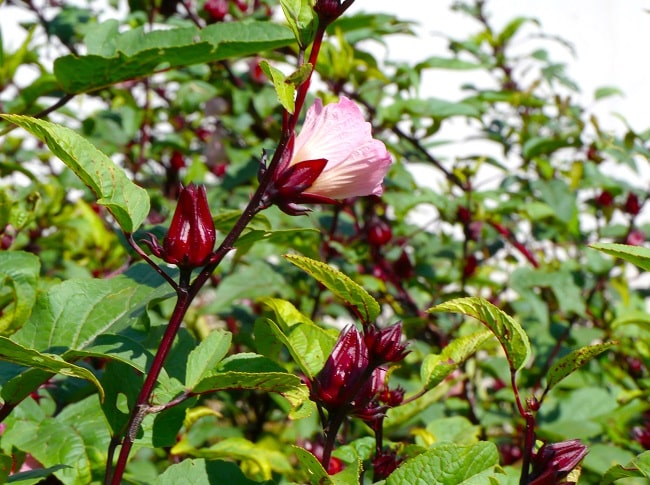
All parts of this Hibiscus plant are edible including the flowers, leaves seeds and roots. Each have been used for centuries in many parts of the world in traditional cooking and medicine.
How To Use the Different Parts of the Hibiscus Sabdariffa
Edible Hibiscus Calyx
The calyx is actually the fruit that protects the seed and develops from the base of the flower petals. It is this part that is used to make jams, jellies, tea, and syrup. It contains vitamins and minerals and is highly beneficial to health. It is also high in pectins which makes it especially good for jams and jellies.
The Hibiscus sabdariffa calyx is known for its pleasantly tart and tangy flavor profile. When infused in hot water, the calyx releases a vibrant red liquid that is widely consumed as herbal tea, often referred to as Hibiscus tea or Roselle tea. The flavour of this tea is refreshingly tart, often likened to cranberries or sour cherries, with a hint of floral undertones.
The calyxes are commonly available as a dried product and can be used in the same way as the fresh ones.
Edible Hibiscus Flowers
The edible flowers of the hibiscus sabdariffa are small and relatively insignificant compared to other hibiscus flowers. They are white or very pale pink in colour with a deep red throat. They only last a day or so, but are very high in nutritional value and provide a good additional to salads.

Edible Hibiscus Leaves
Hibiscus sabdariffa leaves can be used in cooking to add flavor and nutritional benefits to various dishes. These leaves are commonly used in many cuisines around the world, particularly in dishes like stews, soups, and curries. They are known for their slightly spicy and tangy flavor, which can add a unique twist to your dishes.
They can also be eaten raw, sliced up and added to salads or other green vegetables.
Hibiscus sabdariffa leaves are often dried before being used for cooking. This helps to intensify their flavor and ensure a longer shelf life.
Nutritional and Health Benefits of Roselle
Roselle is also a medicinal plant, with various healing properties. The plant contains medically significant compounds such as phytochemicals which has made it an important component to many traditional medicinal recipes.
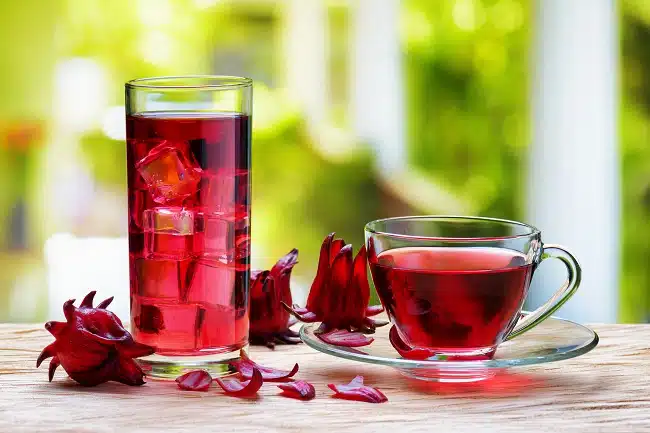
The nutritional composition of the edible Hibiscus flower offers a range of health benefits as it is high in vitamins and minerals. It also possesses exceptional antioxidant properties, providing both anti-inflammatory and antibacterial advantages.
It is suggested that by including roselle in your daily diet, you are actively managing the immune system, inflammatory diseases, and various cardiovascular issues.
Health Benefits of Hibiscus Sabdariffa
- Digestive Health: It is suggested that the seed found in the roselle fruit has diuretic properties that may aid in digestion. These properties are thought to promote increased urination and bowel movements and offer potential benefits in preventing colorectal cancer.
- Heart Health: The flowers, leaves, and calyxes of the plant are believed to be beneficial in preventing heart diseases and controlling blood pressure. However, it is important to manage intake and not exceed recommended quantities. It is also advised that pregnant women should avoid having this product.
- Immune System Support: Fresh hibiscus flowers contain Vitamin C, which is essential to maintain a good immune support system. The high iron content also assists the immune system and contributes to the formation of red blood cells and haemoglobin. It is also suggested to offer anti-inflammatory and mild anti-bacterial elements that are helpful in treating cough and cold
How to Grow Roselle from Seed

The Hibiscus sabdariffa or Roselle is an annual plant and grows best in warm and wet weather with planting done in springtime when the weather is warm.
Choose a sunny and well-draining spot in your garden or use containers if you’re limited on space. When it comes to soil, Roselle prefers to bloom in soil that is rich in organic matter. It’s best to blend the soil with some good compost or well-rotted manure before planting.
Before sowing your roselle seeds, firstly soak them for 24 hours to soften their hard skin. This will help them to germinate and then plant them about 1cm deep and cover lightly with soil.
These seeds need very warm and moist conditions in order to germinate, so keep them watered and in the sunshine.
With proper care and attention, your Roselle plants should grow well and provide you with beautiful flowers and nutritious fruits within a couple of months.
How to Harvest Hibiscus Sabdariffa
The flowering season is towards the end of summer when the days are getting shorter. Once the flower petals have fallen off, the calyxes will start to become fleshy and deep red within 3-7 days. It is then time to harvest.
Firstly, pick the ripe calyx. These plump fruits will need to be snipped as they will not snap easily when ripe. Then take out the round seed pod that is enclosed in the middle and keep for future planting. These calyxes can either be used immediately or else they can be dried for use later. The seeds can be kept and sown the following spring.
Frequently Asked Questions About Hibiscus Sabdariffa
Can you eat Hibiscus raw?
Yes, the hibiscus leaves, flowers and calyxes can be eaten raw. The flowers and leaves are used in salads and fresh dishes and the red calyxes provide a tart but delightful addition to a fruit or savoury dish.
Does Hibiscus sabdariffa affect blood pressure?
Some studies have suggested that drinking hibiscus tea and taking extracts from the Hibiscus sabdariffa can help to lower blood pressure. However always consult your doctor before taking regular quantities of hibiscus tea if you have hypertension.
What are the medicinal uses of the roselle plant?
Extract from the roselle plant has been found to have several applications in the management of diverse health conditions. These include diabetes, high blood pressure, fever, digestive ailments and liver diseases, among others. It also has well-documented therapeutic properties as an anti-inflammatory, antihyperlipidemic, and antihypertensive agent.
When should I harvest roselle?
You should harvest roselle when the calyces (the red, fleshy part) are plump and fully developed. This typically occurs about 10-12 weeks after planting when they are bright red and approximately 1.5 to 2 inches in diameter. Harvest them before they become overripe or begin to dry out. Gently snip the calyxes from the plant, leaving the stems intact for future growth.
How do you make roselle tea?
To make roselle tea, steep dried or fresh roselle calyxes in boiling water for 5-7 minutes, strain, and optionally sweeten to taste. Serve hot or chilled.
Wrapping Up: The Edible Hibiscus Flower and Its Uses
In conclusion, the edible Hibiscus sabdariffa has remarkable versatility, and has a firm reputation as both a useful food and a medicinal plant.
As a food, the edible hibiscus flower is a great addition to a variety of dishes including salads, jams, and teas. It’s wonderfully tangy yet sweet cranberry like flavor provides an interesting taste to many foods and drinks. Its versatility in the kitchen, coupled with its abundant vitamins and antioxidants, makes it a valuable element to one’s diet.
Moreover, its high levels of vitamin C, antioxidants, and potential anti-inflammatory properties make it a worthy contender in the realm of natural medicine. With studies suggesting potential benefits for heart health, digestive health, and even potential anti-cancer properties, the Hibiscus sabdariffa holds a place as a medicinal plant.
If you stay in tropical areas, consider growing this edible hibiscus flower. It is a low-maintenance shrub that even grows wild in Australia!
Aside from its stunning appearance, this versatile plant offers fantastic health benefits and adds great flavour and colour to your dishes!

